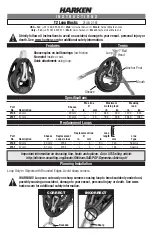
7.5.9
Making the electrical connection to the product
WARNING
High electrical voltage!
Risk of serious injury or death from electric shock.
Disconnect the relevant system component before performing any maintenance
or repair work.
Secure the system against being unintentionally switched on again.
• Choose control and sensor elements in accordance with EN ISO 13849. When
doing so, factor in the load that is to be transported and the transport speed.
• The motor may only be connected by qualifi ed personnel!
• Comply with VDE regulation VDE 0100 for Germany, or corresponding regulations
in the country of use.
Motor connection
• Observe the available supply voltage!
• Observe the electrical power requirement shown on the motor nameplate,
see Fig. 25 on page 33.
• Connect up the motor in either a wye or a delta confi guration in accordance with
the connection diagrams, see Fig. 26 on page 34, and the connection diagram in
the terminal box.
• The motor is fi tted with a bimetal temperature monitoring switch (potential-free
thermal contact, 230 V AC, 300 mA). Wire the motor so that it is de-energized when
the switch is triggered.
• Insert the cable so that it cannot get damaged during operation.
• Optional motor connection with plug (AT = S), see Fig. 31 on page 38. Observe
the pre-fuse!
Checking the rotational direction of the motor
• Let the system run for no more than 2 secs., then make sure the motor is rotating
in the proper direction.
• Switch any two wires (U1, V1 or W1, see Fig. 31 on page 38) to change the
motor's rotational direction.
Please note:
For motors that come with a fi tted plug, correct the rotational direction in the
control cabinet or at the socket contact (socket side). This makes replacement
easier.
Assembly 37/72
3 842 562 241/2019-04, MIT: HQ 2/U-H,
Bosch Rexroth AG
EN
GLISH
















































